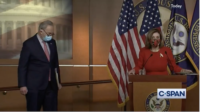Construction History
New Deal Programs Helped End the Great Depression

Image from ENR Archive
Click here for a more detailed image

As reported by ENR at the time, while the Depression deepened in the early 1930s, none of the initiatives taken by President Herbert Hoover or Congress did much to help, and some, such as the Smoot-Hawley Tariff Act, which led to higher prices, were counterproductive. Hoover opposed congressional proposals to offer federal relief to the unemployed, believing such aid should be handled by state and local governments and charities.
A major wave of bank failures occurred in late 1930. Unemployment reached 15% in mid-1931. The annual volume of construction fell 76% from 1928 to 1932. With unemployment at 22% in early 1932, Hoover yielded to congressional pressure and set up the Reconstruction Finance Corp. to make loans to banks, railroads and local governments, but it failed to stimulate commercial lending.
In contrast to Hoover’s laissez-faire approach, New York Gov. Franklin D. Roosevelt was the first governor to publicly endorse the idea of unemployment insurance. As governor he established the Temporary Emergency Relief Administration which over the course of six years helped five million people.
Upon entering the White House in 1933 following the 1932 election, Roosevelt and his “brain trust” quickly crafted a variety of bold ventures to put people back to work and revive a gasping economy. His first program, the Civilian Conservation Corps, sent young men to plant trees, fight forest fires and carry out soil erosion control projects. It got off to a lightning-fast start, with 300,000 workers across 1,400 camps by July 1, 1933, the fastest peacetime mobilization in American history. With their room and board taken care of, workers in the CCC sent much of their one-dollar-per-day pay home to their needy families.
Roosevelt was an advocate for publicly owned power generation, and as governor had launched a state power authority that built large-scale hydroelectric plants. He convinced Congress to create the Tennessee Valley Authority, which built dams to supply cheap electricity to Appalachia, provide flood control and protect the region’s topsoil.
Notwithstanding these two initiatives, Roosevelt was skeptical of the merit of public works. But his advisers, notably Frances Perkins and Raymond Moley, helped to convince him. In June 1933, Roosevelt signed the National Industrial Recovery Act. Title 1 of NIRA promoted cooperation among businesses to achieve fair competition, while Title 2 created the Public Works Administration and unleashed billions of dollars for tens of thousands of infrastructure projects, employing millions of people. The Grand Coulee Dam in Washington, Fort Peck Dam in Montana, the All-American Canal in California and New York City’s Triborough Bridge are a few of the largest projects funded by the PWA.
ENR pushed for a federal public works program to fight the Depression as early as September 1931, stating in an editorial: “Public works can employ the idle and can make available to them, not by gift but by right of labor the stores of food, clothing and shelter, of which the country has abundance. Private business has proved powerless to maintain the workers at their jobs. A national emergency lies ahead, but if the will to provide it is strong enough work can be found for all.” An editorial in 1932 was harsher. “Sedatives in the form of budget balancing and bank credit rehabilitation no longer bear hope of increasing the increased purchasing power needed to stimulate industry. Work is the only remedy, and only work on public construction is available.”
As Congress debated NIRA, ENR devoted 20 pages of its May 18, 1933 issue to articles by leading public figures making the case for the value of public works. Interior Sec. Harold Ickes, California State Engineer Edward Hyatt, Engineer Malcolm Pirnie and Director of Public Administration Clearing House Louis Brownlow, whose article was titled “The Citizen as Stockholder in Public Facilities,” all weighed in.
The following week’s editorial was a full-throated endorsement. “Civil engineers should find special gratification in the fact the bill embodies in full the principle which they and Engineering News-Record have urged upon the government throughout the past year, namely, utilization of employment through public works construction as the spearhead of attack on depression and deflation. In thus acknowledging the nation’s responsibility for re-establishment of worker earning power, the bill discards many bankrupted traditions and sets a new course oriented by the public welfare.”
Title 1 of NIRA mandated that industries develop codes of fair competition that would prevent destructive price cutting, set wage and hour standards and protect the rights of labor unions. Getting 21 major organizations of contractors, engineers, architects and unions to hammer out the construction code took until January 1934. ENR applauded these efforts. “For years this industry has stood in bitter need of coordination, yet until now it succeeded only in remaining apart, a group of separate and virtually antagonistic elements. The result was continuing inefficiency, discord and dispute…. Under the code the industry can solve its most urgent labor problems. It can wipe out the bad practices that were a permanent bar to sound and efficient existence. It can set out on a course of industry planning and direction of its operations that should lead to progressively greater stability.” The voluntary workers’ rights protections in the NIRA would eventually become a mandatory national minimum wage and maximum hours standards, and a ban on child labor.
Roosevelt also created a short-term jobs program, the Civil Works Administration, for the duration of the hard winter of 1933-34, which employed four million onetime relief recipients in mostly manual labor jobs, such as road grading, sidewalk and sewer line construction and painting public buildings. It resulted in 255,000 miles of improved roads, 2,200 miles of sewer lines, and 4,000 new or improved school buildings.
Another ENR initiative supporting the government’s public works programs was undertaken by Elsie Eaves, manager of ENR’s business news department and a degreed civil engineer. From 1933-35 she organized and directed an inventory of needed construction projects that could go ahead if federal funding was provided. This helped Congress pass loan-grant legislation to revive construction activity.
Rural America lagged far behind cities in terms of electrical service. Only 10% of American farms had electricity. The Rural Electrification Act of 1935 gave loans to rural electric cooperatives to set up networks of transmission and distribution lines and purchase power wholesale. By 1942 nearly 50% of farms had electricity.
Although the PWA funded the demolition of slum housing and the construction of some public housing, the 1937 creation of the U.S. Housing Authority solidified and greatly expanded that commitment.
By 1936 unemployment had dropped to 9.9%, the stock market was on the upswing and bank failures were minimal. While the economy did not fully recover for several more years, economists generally agree that public works programs had the highest economic multipliers of the various New Deal programs.



